
Winter 2014, Abydos, Egypt—The first clues were nothing extraordinary—a line of mudbricks in the sand, not unlike the first evidence of many of the other tombs already found in this ancient, sacred place.
But digging down further, the excavators could see something different about this one. The line of bricks eventually became walls, and the walls became a decorated burial chamber. Wall paintings depicted images of the Egyptian gods Isis, Nut, Nephthys, and Selket, surrounding a canopic shrine. Among the paintings was a royal cartouche. Cartouches always meant names. This one belonged to ‘Woseribre Senebkay’—a virtual unknown among the pharaonic lists. The tomb had all the hallmarks of a royal tomb, but the name didn’t ring any bells for the excavators.
Teams from the University of Pennsylvania’s Museum of Archaeology and Anthropology (Penn Museum), currently headed by Josef Wegner, have been excavating in this area, the southern part of the ancient site of Abydos, since 1994 as part of the combined University of Pennsylvania-Yale-Institute of Fine Arts/New York University Expedition. Abydos is best known as the ancient sacred center of the cult of Osiris, king of the afterlife and god of the netherworld. As an important cult center, it was long a place of pilgrimage for ancient Egyptians, and it was here that Egypt’s Predynastic (4000 – 3000 BCE) kings were buried, along with later pharaohs. The tombs being excavated by Wegner’s team were constructed by some of these later pharaohs, including a royal tomb they had most recently investigated, belonging to a familiar pharaoh—that of Sobekhotep I, the first 13th dynasty king who ruled Egypt around 1800 BCE. Only a year before, they discovered his 60-ton red quartzite royal sarcophagus chamber.
But who was this Senebkay?
Further excavation of this mystery tomb revealed an antechamber (now dated to Egypt’s Second Intermediate Period, or 1650 to 1550 BCE) containing skeletal remains, presumably of Senebkay himself. Also with his remains was his canopic chest, and fragments of a mummy mask. The condition and positioning of the objects had all the signs that the tomb had been plundered anciently by robbers—what was left was only debris, his mummy having been torn apart in antiquity, his coffin and canopic chest in fragments, and the original gild surfaces of his other tomb equipment long gone. But for archaeologists, there was enough information here to keep them busy for years. The skeletal remains alone contained a wealth of information, and as modern forensic science would have it, the scientists were in for a fascinating up-close-and-personal encounter with a pharaoh who, until January, 2014, no one knew existed.
A Violent Death
Initial examination of Senebkay’s skeleton by University of Pennsylvania graduate students and team members Paul Verhelst and Matthew Olson suggested the king was moderate in height, about 5’10, and that he died in his mid-to-late 40s.
But further study revealed much more. A more detailed examination by Dr. Maria Rosado and Dr. Jane Hill of Rowan University pinpointed his death at 35 to 40 years of age, and showed clear evidence of multiple wounds to his body. They documented no less than 18 wounds, including cuts to his lower back, knees, ankles, feet, and hands. But, according to the examiners, death likely came as evidenced by three major wounds to his skull. More telling, the wounds matched the distinctive size and shape of well-known battleaxes used in warfare during Egypt’s Second Intermediate Period. And more telling still, the pattern of most of the wounds suggested that they had been inflicted while he was in an elevated position.
A few possible scenarios could explain this. One stands out—evidence on the femur and pelvis bones of muscle attachments indicated he had spent a significant amount of his life on horseback.
Was Senebkay slain in battle or in an ambush while on horseback?
The researchers suggest this as a real possibility. He may have been, like other pharaohs known from later periods, a warrior king, fighting alongside his troops. Another king’s remains discovered in a tomb near Senebkay’s also indicated a life of horseback riding, additional evidence that Second Intermediate Period kings were already riding horses, a skill that was not known to have been commonly employed in battle until after the Bronze Age. Was horseback riding beginning to play an increasing role in military campaigns as early as the Second Intermediate Period? The researchers hope that further discoveries and research will shed more light on the question.
In any case, for the first time, archaeologists had what appeared to be first evidence of a long-forgotten Egyptian pharaoh who likely met a dramatic and viciously dealt death—what today could be the stuff of a cinematic production.
Other key questions revolve around whom he might have fought and where the battle took place, assuming by interpretation that he died in battle. His remains indicated that a significant amount of time passed between the time of his death and actual burial, suggesting that his body may possibly have been transported from a distant location to the place of burial. But this is where the evidence stops. Based on what scholars know about the history of the region, the king may have died fighting the Hyksos. The ancient record reflects 15th Dynasty Hyksos rule of northern Egypt at that time. Alternatively, he may have died in battle against possible enemies such as the 16th Dynasty Thebans to the south, or the Nubians, who according to written records from his time invaded Egypt from the south at least once. These are questions that await further research.
______________________________________
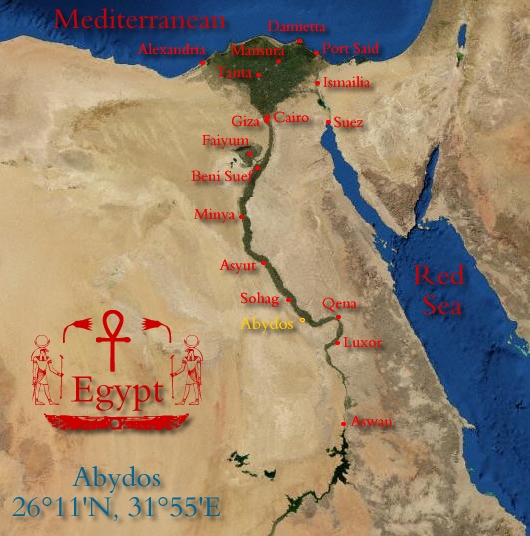 Abydos (in yellow) in relation to other sites of Egypt.
Abydos (in yellow) in relation to other sites of Egypt.
__________________________________
 Team members work to excavate the burial chamber of the pharaoh Woseribre Senebkay, with sheets covering a painted wall decoration. Photo: Josef Wegner, Penn Museum.
Team members work to excavate the burial chamber of the pharaoh Woseribre Senebkay, with sheets covering a painted wall decoration. Photo: Josef Wegner, Penn Museum.
____________________________________________________
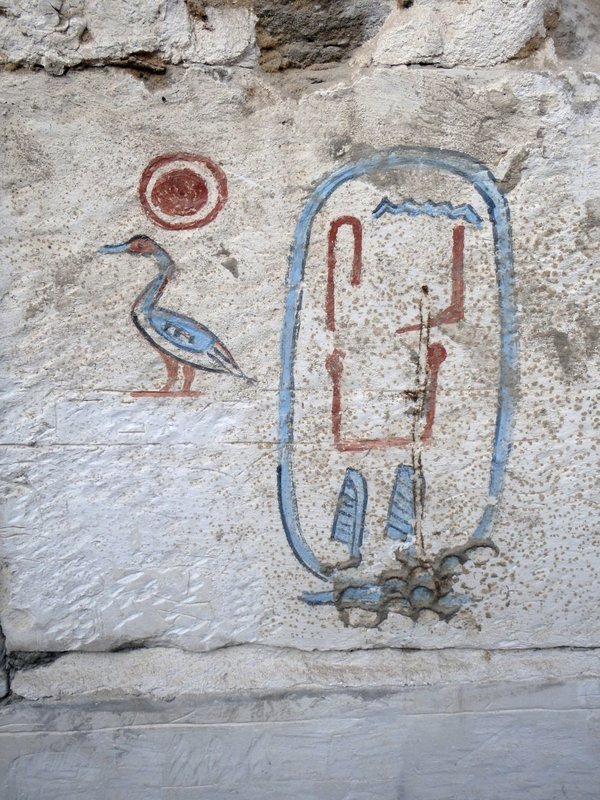 At left, the sun disc and goose means “Son of Re” (or Ra), the Egyptian sun god. The cartouche at right spells the name of the pharaoh, Senebkay, whose body was interred in this tomb. Photo: Jennifer Wegner, Penn Museum.
At left, the sun disc and goose means “Son of Re” (or Ra), the Egyptian sun god. The cartouche at right spells the name of the pharaoh, Senebkay, whose body was interred in this tomb. Photo: Jennifer Wegner, Penn Museum.
_____________________________________
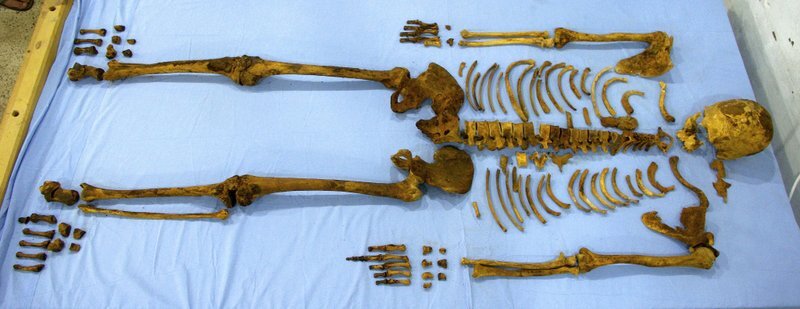 The skeleton of pharaoh Woseribre Senebkay. Originally mummified, the body was ripped apart by robbers in antiquity. Photo: Josef Wegner, Penn Museum
The skeleton of pharaoh Woseribre Senebkay. Originally mummified, the body was ripped apart by robbers in antiquity. Photo: Josef Wegner, Penn Museum
__________________________________________________
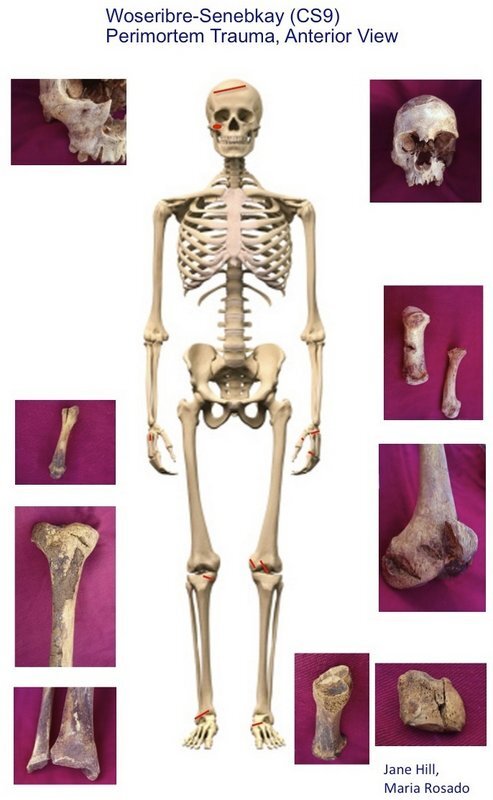 Schematic showing the distribution of traumatic battle wounds to Senebkay: front view. Image: Dr. Jane Hill.
Schematic showing the distribution of traumatic battle wounds to Senebkay: front view. Image: Dr. Jane Hill.
____________________________________________________
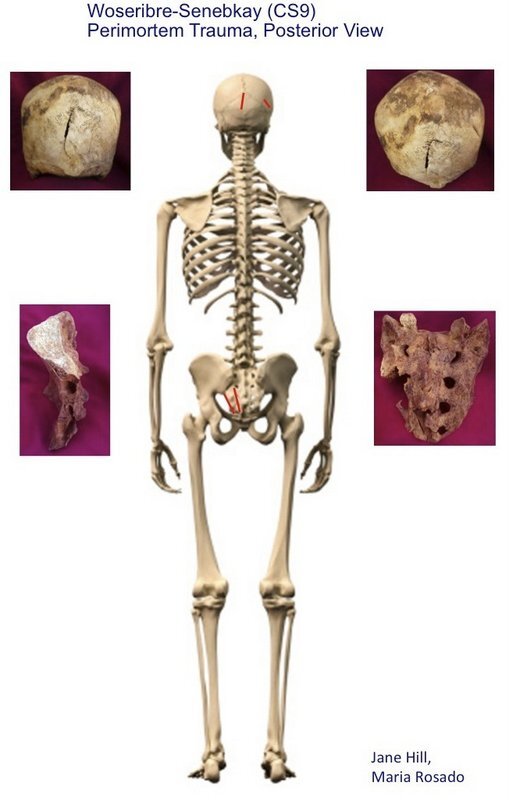 Schematic showing the distribution of traumatic battle wounds to Senebkay: rear view. Image: Dr. Jane Hill.
Schematic showing the distribution of traumatic battle wounds to Senebkay: rear view. Image: Dr. Jane Hill.
___________________________________________________
 Image composite depicting the right ankle and left knee of Woseribre Senebkay’s skeleton. The patterns of wounds to Senebkay’s body suggest he was attacked while in an elevated position relative to his assailants, quite possibly mounted on horseback. Image: Jane Hill and Josef Wegner.
Image composite depicting the right ankle and left knee of Woseribre Senebkay’s skeleton. The patterns of wounds to Senebkay’s body suggest he was attacked while in an elevated position relative to his assailants, quite possibly mounted on horseback. Image: Jane Hill and Josef Wegner.
__________________________________________________
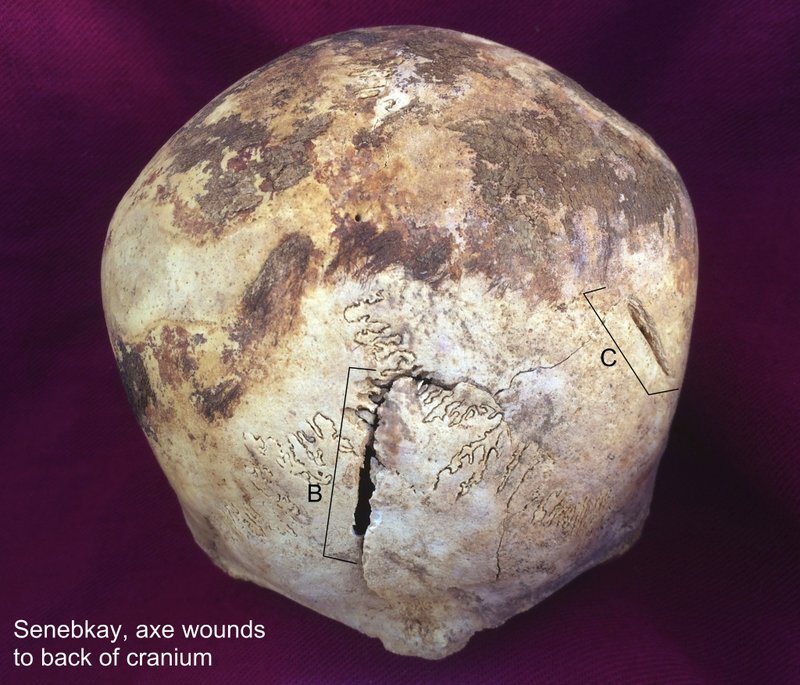 Rear view of Woseribre Senebkay’s skull, indicating the locations of two axe wounds to the back of the cranium. Photo: Jane Hill and Josef Wegner.
Rear view of Woseribre Senebkay’s skull, indicating the locations of two axe wounds to the back of the cranium. Photo: Jane Hill and Josef Wegner.
_________________________________________________
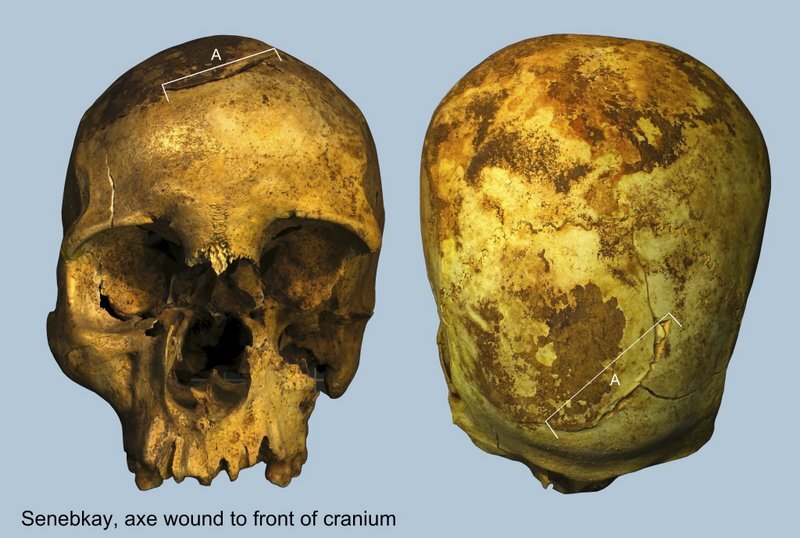 Front and top views of Woseribre Senebkay’s skull, indicating the location of an axe wound to the front of the cranium. This and two other major blows to Senebkay’s skull preserve the distinctive size and curvature of battle axes used during Egypt’s Second Intermediate Period. Photo: Josef Wegner, Penn Museum.
Front and top views of Woseribre Senebkay’s skull, indicating the location of an axe wound to the front of the cranium. This and two other major blows to Senebkay’s skull preserve the distinctive size and curvature of battle axes used during Egypt’s Second Intermediate Period. Photo: Josef Wegner, Penn Museum.
________________________________________________
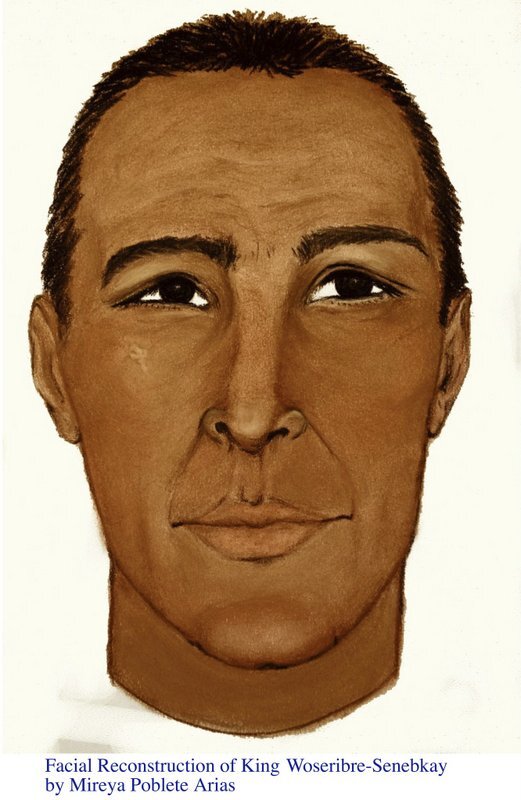 A facial reconstruction of the pharaoh Senebkay based on the detailed cranial study, by Mireya Poblete Arias. Image: Mireya Poblete Arias.
A facial reconstruction of the pharaoh Senebkay based on the detailed cranial study, by Mireya Poblete Arias. Image: Mireya Poblete Arias.
_____________________________________________
A Dynasty Lost and Found
The Penn Museum excavations at Abydos have focused primarily on the subterranean tomb of the powerful and well-known 12th Dynasty Middle Kingdom pharaoh Senwosret III, his mortuary temple and associated structures, a related royal town settlement known as Wah-Sut, and a New Kingdom cemetery further to the north. Senwosret was significant for a number of reasons, not the least of which was the nature of his burial—instead of being interred within a traditional royal pyramid like his forerunners, he chose to be buried in a subterranean tomb. This was a first, giving rise eventually to the well-known underground tomb concept popularly associated with the royal tombs of the New Kingdom pharaohs in the Valley of the Kings.
Much is known about the 12th Dynasty and its kings, but recent excavations have turned up evidence bearing on an Egyptian Second Intermediate period series of kings of which Egyptologists, until now, have known next to nothing—in essence, a lost 13th Dynasty of kings, of which Senebkay was one.
As the excavators found, the tomb of Senebkay proved to be comparatively modest in scale and showed reuse of materials from the earlier Middle Kingdom, such as decayed cedar wood remains of his canopic chest, which still bore the name of Sobekhotep I beneath its gild covering. This, along with other evidence, suggested a kingdom with far more limited resources than the previous Middle Kingdom. But the discovery provides new evidence of the existence of a forgotten Abydos Dynasty contemporary with the 16th Theban Dynasty to its south and the 15th Hyksos Dynasty to its north.
There is now evidence for about 16 royal tombs spanning the period of this lost dynasty. Tombs of seven of them have been excavated, of which Senebkay’s, dated to 1650 BCE, is the most recently uncovered, revealing clues to a time and series of pharaohs that until now were not known to exist.
Who were these kings and what was their place in history? Sandwiched between their Hyksos and Theban Dynasty contemporaries, did they vie with them for power and control of all of ancient Egypt, or simply defend themselves in efforts to hold on to what they had, including invasions from the Nubians further to the south? Do Senebkay’s fatal wounds tell a story that could have anything to do with any of these potential scenarios? Wegner’s team, including other researchers, may find answers to these questions as they continue their investigations.
“It’s exciting to find not just the tomb of one previously unknown pharaoh, but the necropolis of an entire forgotten dynasty,” stated Dr. Wegner in a Penn Museum press release*. “Continued work in the royal tombs of the Abydos Dynasty promises to shed new light on the political history and society of an important but poorly understood era of Ancient Egypt.”
________________________________________________________
 The exposed tomb of Woseribre Senebkay. Here, a LiDAR instrument and spheres were set up to create a precise digital map of the tomb. As an essential part of investigating the area in which the tomb was located, researchers utilized technology such as LiDAR ( Light Detection And Radar), as well as magnetometry and ground penetrating radar. Photo courtesy Paul Verhelst
The exposed tomb of Woseribre Senebkay. Here, a LiDAR instrument and spheres were set up to create a precise digital map of the tomb. As an essential part of investigating the area in which the tomb was located, researchers utilized technology such as LiDAR ( Light Detection And Radar), as well as magnetometry and ground penetrating radar. Photo courtesy Paul Verhelst
_______________________________________________________
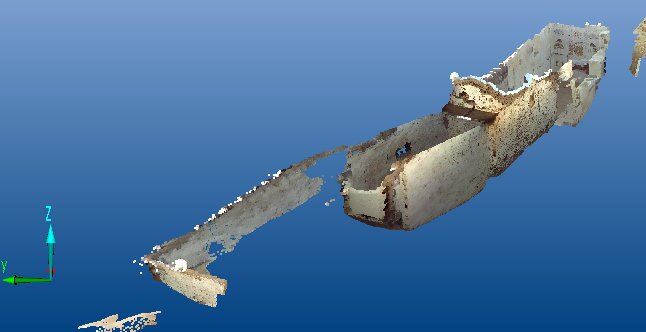 Above: Graphic results of the LiDAR scanning of Senebkay’s tomb. With carefully employed LiDAR scanning, team member Paul Verhelst was able to produce this 3D model of the tomb as excavated. Photo courtesy Paul Verhelst
Above: Graphic results of the LiDAR scanning of Senebkay’s tomb. With carefully employed LiDAR scanning, team member Paul Verhelst was able to produce this 3D model of the tomb as excavated. Photo courtesy Paul Verhelst
_____________________________________________________
_____________________________________________________
See more about the Penn Museum, and its many exhibits and research projects at its website.
________________________________________
Subscribe to Popular Archaeology Premium. Available on all laptops and mobile devices, and still the industry’s best value at only $9.00 annually.
___________________________________________
Travel and learn with Far Horizons.
____________________________________________
This richly illustrated issue includes the following stories: Recent findings shedding new light on the whereabouts of the remains of Philip of Macedon, father of Alexander the Great; how an archaeologist-sculptor is bringing bones of the dead back to life; archaeologists uncovering town life at the dawn of civilization; an exclusive interview with internationally acclaimed archaeologist James M. Adovasio about what makes the Meadowcroft Rockshelter prominent in the ongoing search for the first Americans; what archaeologists are finding at the site of the ancient city of Gath, the home town of the biblical Philistine giant, Goliath; and how scientists are redrawing the picture of human evolution in Europe. Find it on Amazon.com.




